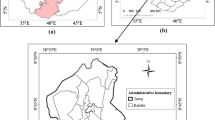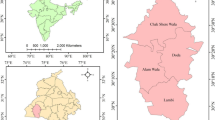Abstract
The main objective of the present study is to enhance the accessibility facilities for local public to educational centers in Tiruchirappalli City. For this approach, the existing K-12 schools, Census tracts and road network were spatially plotted using the techniques of geospatial system. Spatial accessibility index is computed using Three-step floating catchment area (3SFCA) method. The findings indicate (39%) of catchment area has been shortage of education facilities. The index of 3SFCA and its spatial pattern has been compared, validated using enhanced two-step floating catchment area (E2SFCA) method. The incorporated Gaussian weight of 3SFCA clearly reduces the high estimate of demand problem of the study area. Through 3SFCA and E2SFCA, the number of wards observed to be shortage is 14 and 26 respectively. Overall, the analysis concludes that 3SFCA is an effective method in spatial planning of educational facilities. In future, this study enables the urban planners and decision makers to maximize spatial accessibility by establishing a new facility and improve the existing facilities in shortage region.









Similar content being viewed by others
References
Oberti, M. (2007). Social and school differentiation in urban space: Inequalities and local configurations. Environment and Planning A, 39(1), 208–227. https://doi.org/10.1068/a39159.
Joshi, P. (2017). A perspective on education’s importance for urban development. European Journal of Education, 52(4), 421–426. https://doi.org/10.1111/ejed.12234.
Begna, T. N. (2017). Public schools and private schools in Ethiopia: Partners in national development? International Journal of Humanities, Social Sciences and Education, 4(2), 100–111. https://doi.org/10.20431/2349-0381.0402010.
Gao, Y., He, Q., Liu, Y., Zhang, L., Wang, H., & Cai, E. (2016). Imbalance in spatial accessibility to primary and secondary schools in China: Guidance for education sustainability. Sustainability. https://doi.org/10.3390/su8121236.
Wazzan, K. (2017). The spatial distribution of the basic education schools in Lattakia City (Syria). Journal of Educational and Social Research, 7(1), 71–79. https://doi.org/10.5901/jesr.2017.v7n1p71.
De la Fuente, H., Rojas, C., Salado, M. J., Carrasco, J. A., & Neutens, T. (2013). Socio-spatial inequality in education facilities in the Concepción Metropolitan Area (Chile). Current Urban Studies, 01(04), 117–129. https://doi.org/10.4236/cus.2013.14013.
Bulti, D. T., Bedada, T. B., & Diriba, L. G. (2019). Analyzing spatial distribution and accessibility of primary schools in Bishoftu Town, Ethiopia. Spatial Information Research, 27(2), 227–236. https://doi.org/10.1007/s41324-018-0227-6.
Bikdeli, S., Shafaqi, S., & Vosouqi, F. (2017). Accessibility modeling for land use, population and public transportation in Mashhad, NE Iran. Spatial Information Research, 25(3), 481–489. https://doi.org/10.1007/s41324-017-0116-4.
Dinda, S., Ghosh, S., & Das Chatterjee, N. (2019). An analysis of transport suitability, modal choice and trip pattern using accessibility and network approach: a study of Jamshedpur city, India. Spatial Information Research, 27(2), 169–186. https://doi.org/10.1007/s41324-018-0223-x.
Oberti, M., & Savina, Y. (2019). Urban and school segregation in Paris: The complexity of contextual effects on school achievement: The case of middle schools in the Paris metropolitan area. Urban Studies. https://doi.org/10.1177/0042098018811733.
Abraha, T. A. (2019). Analyzing spatial and non-spatial factors that influence educational quality of primary schools in emerging regions of Ethiopia: Evidence from geospatial analysis and administrative time series data. Journal of Geography and Regional Planning, 12(1), 10–19. https://doi.org/10.5897/jgrp2018.0705.
Ogunyemi, S. A., Muibi, K. H., Eguaroje, O. E., Fabiyi, O. O., & Halilu, A. S. (2014). A geospatial approach to evaluation of accessibility to secondary educational institution in Ogun State, Nigeria. IOP Conference Series: Earth and Environmental Science. https://doi.org/10.1088/1755-1315/20/1/012045.
Agrawal, S., & Gupta, R. D. (2016). School mapping and geospatial analysis of the schools in Jasra development block of India. International Archives of the Photogrammetry, Remote Sensing and Spatial Information Sciences—ISPRS Archives, 41(July), 145–150. https://doi.org/10.5194/isprsarchives-XLI-B2-145-2016.
Ye, H., & Kim, H. (2014). Measuring spatial health disparity using a network-based accessibility index method in a GIS environment: A case study of hillsborough measuring spatial health disparity using a network-based accessibility. International Journal of Geospatial and Environmental Research, 1(1), 2.
Fryer, R. G. (2011). Financial incentives and student achievement: Evidence from randomized trials. Quarterly Journal of Economics, 126(4), 1755–1798. https://doi.org/10.1093/qje/qjr045.
County, B., Murimi, M., Musiega, D., & Mulefu, F. O. (2012). Planning and analysis of educational facilities using GIS: A case study of Busia County, Kenya. In Conference: AGSE 2012.
Al-Rasheed, K., & El-Gamily, H. I. (2013). GIS as an efficient tool to manage educational services and infrastructure in Kuwait. Journal of Geographic Information System, 05(01), 75–86. https://doi.org/10.4236/jgis.2013.51008.
Hameed, N. H. (2016). On the use of GIS technique to analyze the distribution of primary schools in Holy Karbala City. Engineering and Technology Journal, 34(15 Part (A)), 2816–2827.
Al-Enazi, M., Mesbah, S., & Anwar, A. (2016). Schools distribution planning using GIS in Jeddah City. International Journal of Computer Applications, 138(1), 33–36. https://doi.org/10.5120/ijca2016908693.
Rekha, R. S., Wajid, S., Radhakrishnan, N., & Mathew, S. (2017). Accessibility analysis of health care facility using geospatial techniques. Transportation Research Procedia, 27, 1163–1170. https://doi.org/10.1016/j.trpro.2017.12.078.
ASER Centre. (2019). Annual status of education report (rural) 2018, 1–335. http://img.asercentre.org/docs/ASER2018/ReleaseMaterial/aserreport2018.pdf.
Prabhat, J., Ashish, D., & Gowri, I. (2014). Private sector’s contribution to K-12 education in India. FICCI—Ernst & Young Report. Retrived March 2014, from http://ficci.in/spdocument/20385/ey-ficci-report-education.pdf.
AISHE Survey. (2015). National Data sharing and Accessibility Policy. Ministry of Human Resource Development. Retrived August 2015, from https://data.gov.in/catalog/pupil-teacher-ratio-aishe-survey?filters%5Bfield_catalog_reference%5D=258323&format=json&offset=0&limit=6&sort%5Bcreated%5D=desc.
UNESCO Institute of Statistics. (2015). http://data.uis.unesco.org/.
UNESCO. (2017). Literacy rates continue to rise from one generation to the next. UNESCO, 2016(45), 1–13.
Bai J (2013) Accessibility to essential services and facilities by aged population in the local government area of Monash: A GIS-based case study. Master thesis. RMIT University.
Ogunyemi, S. (2015). Spatial distribution and accessibility to post primary educational institution in Ogun State, Southwestern Nigeria: Case study of Yewa South Local Government Area, Nigeria. Journal of Scientific Research and Reports, 5(7), 542–552. https://doi.org/10.9734/JSRR/2015/12328.
Schuurman, N., Bérubé, M., & Crooks, V. A. (2010). Measuring potential spatial access to primary health care physicians using a modified gravity model. The Canadian Geographer/Le Geographe Canadien, 54(1), 29–45. https://doi.org/10.1111/j.1541-0064.2009.00301.x.
Wan, N., Zou, B., & Sternberg, T. (2012). A three-step floating catchment area method for analyzing spatial access to health services. International Journal of Geographical Information Science, 26(6), 1073–1089. https://doi.org/10.1080/13658816.2011.624987.
Luo, W., & Wang, F. (2003). Measures of spatial accessibility to health care in a GIS environment: Synthesis and a case study in the Chicago region. Environment and Planning B: Planning and Design, 30(6), 865–884. https://doi.org/10.1068/b29120.
Kumar, S., Radhakrishnan, N., & Mathew, S. (2014). Land use change modelling using a Markov model and remote sensing. Geomatics, Natural Hazards and Risk, 5(2), 145–156. https://doi.org/10.1080/19475705.2013.795502.
Ravi, S. M., & Ias, K. (2014). District handbook. Deputy Director of Statistics, Town & Local Planning Authority. https://cdn.s3waas.gov.in/s3bca82e41ee7b0833588399b1fcd177c7/uploads/2018/06/2018062116.pdf.
Zhao, M., Xu, G., & Li, Y. (2016). Evaluating urban public facilities of Shenzhen by application of open source data. Geo-Spatial Information Science, 19(2), 129–139. https://doi.org/10.1080/10095020.2016.1176724.
Oluwadare, O. I., & Julius, O. (2011). Regional analysis of locations of public educational facilities in Nigeria: The Akure region experience. Journal of Geography and Regional Planning, 4(7), 428–442.
Lee, J. E., Sung, J. H., & Malouhi, M. (2015). Statistical validation of aweb-based GIS application and its applicability to cardiovascular-related studies. International Journal of Environmental Research and Public Health, 13(1), 1–11. https://doi.org/10.3390/ijerph13010002.
Acknowledgements
The authors wish to thank everyone who contributed to this research work. They gratefully acknowledge the National Remote Sensing Centre (NRSC) of India for readily providing the QuickBird Satellite data. The authors are also very thankful to the Centre of Excellence in Transportation Engineering (CETransE), Department of Civil Engineering, National Institute of Technology Tiruchirappalli (MHRD, GoI) for providing the necessary facilities and the platform for enabling the successful completion of this research work. The authors would also like to express their sincere gratitude to the Tiruchirappalli City Municipal Corporation and Tiruchirappalli Local Planning Authority for providing the population data essential for this investigative research work. The authors wish to place on record the important contribution of the [general/local] public who willingly participated in the questionnaire survey used for data collection.
Author information
Authors and Affiliations
Corresponding author
Ethics declarations
Conflict of interest
Authors state that there is no conflict of interest.
Additional information
Publisher's Note
Springer Nature remains neutral with regard to jurisdictional claims in published maps and institutional affiliations.
Rights and permissions
About this article
Cite this article
Rekha, R.S., Radhakrishnan, N. & Mathew, S. Spatial accessibility analysis of schools using geospatial techniques. Spat. Inf. Res. 28, 699–708 (2020). https://doi.org/10.1007/s41324-020-00326-w
Received:
Revised:
Accepted:
Published:
Issue Date:
DOI: https://doi.org/10.1007/s41324-020-00326-w




